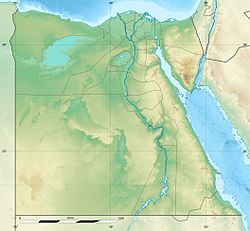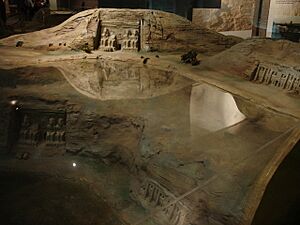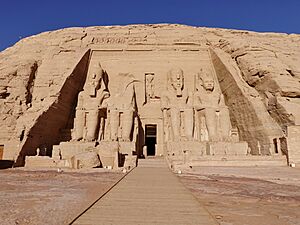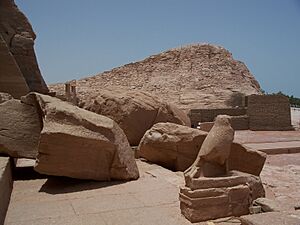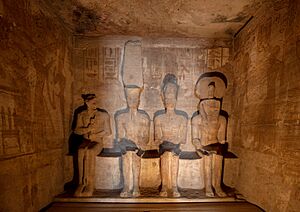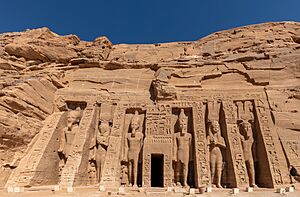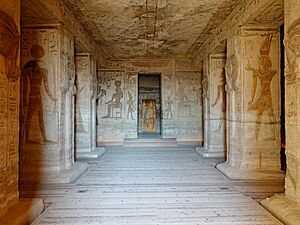Abu Simbel facts for kids
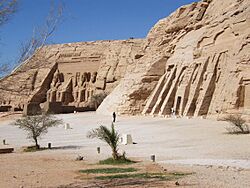
The Great Temple of Ramesses II (left) and the Small Temple of Hathor and Nefertari (right).
|
|
| Location | Aswan Governorate, Egypt |
|---|---|
| Region | Nubia |
| Coordinates | 22°20′13″N 31°37′32″E / 22.33694°N 31.62556°E |
| Type | Temple |
| History | |
| Builder | Ramesses II |
| Founded | Approximately 1264 BC |
| Periods | New Kingdom of Egypt |
| Official name | Nubian Monuments from Abu Simbel to Philae |
| Type | Cultural |
| Criteria | i, iii, vi |
| Designated | 1979 (3rd session) |
| Reference no. | 88 |
| Region | Arab States |
Abu Simbel is an amazing historic site in Egypt. It has two huge temples carved right into the rock. These temples are near the border with Sudan, on the western side of Lake Nasser.
The temples were built a very long time ago, around 1264 BC. This was during the time of Pharaoh Ramesses II. He was a powerful king from the 19th Dynasty of Egypt. The temples have giant statues of Ramesses II carved on the outside. You can also see smaller statues of his wife, Nefertari, and their children near his feet. Inside the main temple, there are carvings that show Ramesses II being a hero in the Battle of Kadesh.
In 1968, something incredible happened. The entire temple complex was moved to higher ground! This was done to save it from being covered by the waters of Lake Nasser. Lake Nasser was created by the Aswan Dam. This huge project was part of an international effort to save ancient monuments.
Abu Simbel and other temples that were moved are now part of a UNESCO World Heritage Site. This means they are very important places that are protected for everyone to see.
Contents
History of the Temples
Building the Temples
During his rule, Ramesses II built many temples all over Egypt and in a region called Nubia. Nubia was important because it had lots of gold and other valuable goods. Ramesses built grand temples there to show how powerful Egypt was. He also wanted to share Egyptian culture with the people of Nubia.
The most famous temples he built are the ones at Abu Simbel. There are two main temples. The Great Temple was built for Ramesses II himself. The Small Temple was built for his main wife, Queen Nefertari.
Building these temples started around 1264 BC and took about 20 years. They were known as the "Temple of Ramesses, Beloved by Amun".
Finding the Temples Again
Over time, the temples were not used anymore. The Great Temple slowly became covered by sand. By 600 BC, the sand already covered the main statues up to their knees. People in Europe forgot about the temples for a long time.
In 1813, a Swiss explorer named Johann Ludwig Burckhardt found the small temple. He also saw the top part of the main temple. He told an Italian explorer, Giovanni Battista Belzoni, about his discovery. Belzoni tried to dig out the entrance to the temple but couldn't at first. He came back in 1817 and finally managed to get inside the complex.
Moving the Temples to Safety
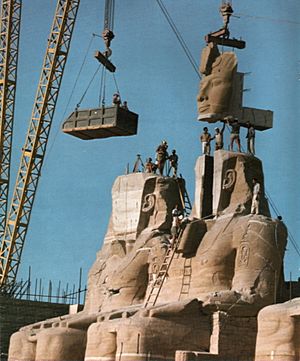
In 1959, people from all over the world started a campaign to save the ancient monuments in Nubia. The Aswan High Dam was being built, and the rising waters of the Nile River would flood these important sites.
One idea was to build a clear dam around the temples. This would keep the water inside at the same level as the Nile. There would even be special rooms to view the temples underwater!
However, a different plan was chosen. From 1964 to 1968, a team of experts from many countries worked together. They carefully cut the entire temple site into huge blocks. Some blocks weighed up to 30 tons! Then, they lifted and put the blocks back together in a new spot. This new location was 65 meters higher and 200 meters further back from the river. It was one of the biggest engineering challenges in history! This amazing project cost about $40 million.
Today, many tourists visit the temples every day. Most people travel by road from Aswan, the closest city. Others fly to Abu Simbel Airport, which was built just for the temple complex.
The Abu Simbel complex has two temples. The larger one is for the gods Ra-Horakhty, Ptah, and Amun. It also honors Ramesses II himself. The smaller temple is for the goddess Hathor. It also honors Nefertari, Ramesses's favorite wife. Both temples are now open for visitors.
The Great Temple
The Great Temple at Abu Simbel took about 20 years to build. It was finished around 1265 BC. It was dedicated to the gods Amun, Ra-Horakhty, and Ptah. It also honored Ramesses II as a god. Many people think it is the most beautiful temple built by Ramesses II.
The Entrance
The entrance to the Great Temple has four giant statues. Each statue is 20 meters tall. They all show Ramesses II sitting on a throne. He wears the double crown of Upper and Lower Egypt. The statue on the left side of the entrance was damaged in an earthquake. Its head and body fell off. When the temple was moved, these pieces were left at the statue's feet, just as they were found.
Next to Ramesses's legs are smaller statues. These statues are not taller than his knees. They show his main wife, Nefertari, his mother, and his first sons and daughters.
Above the statues, the front of the temple is 33 meters high and 38 meters wide. It has carvings of 22 baboons. They are shown worshipping the rising sun with their arms raised. There is also a stone carving that tells about Ramesses's marriage to a Hittite princess. This marriage helped bring peace between Egypt and the Hittites.
Above the entrance door, there are carvings of the king worshipping Ra Horakhty. This god has the head of a falcon.
Inside the Temple
The inside of the temple is shaped like a triangle. The rooms get smaller as you go deeper into the temple, towards the most sacred area. The temple is quite complex and has many side rooms.
The main hall, called the hypostyle hall, is 18 meters long and 16.7 meters wide. It has eight huge pillars. These pillars show Ramesses as the god Osiris. Osiris was the god of life and the afterlife. This shows that the pharaoh was believed to live forever. The statues on the left wall wear the white crown of Upper Egypt. The statues on the other side wear the double crown of Upper and Lower Egypt.
The walls of this hall have carvings that show Ramesses's military battles. Many carvings show the Battle of Kadesh. This was a fight between the Egyptians and the Hittites in modern-day Syria. The most famous carving shows Ramesses on his chariot, shooting arrows at his enemies. Other scenes show Egyptian victories in Libya and Nubia.
From this main hall, you go into a second hall with four pillars. These pillars have beautiful scenes of offerings to the gods. You can see Ramesses and Nefertari with the sacred boats of Amun and Ra-Horakhty. This hall leads to a smaller room, which has the entrance to the sanctuary.
In the sanctuary, there are four seated statues carved into the rock. These are Ra-Horakhty, the deified King Ramesses, Amun Ra, and Ptah. These were the most important gods at that time.
Sunlight in the Sanctuary
Ancient Egyptian builders were very clever. They positioned the temple so that on October 22 and February 22, the sun's rays would shine into the sanctuary. The sunlight would light up the statues on the back wall. Only the statue of Ptah would stay in the dark. Ptah was a god connected to the underworld.
People believe these dates were Ramesses's birthday and coronation day. There is no direct proof, but it's likely these dates were important. This sunlight event was thought to give the king's statue new energy from the sun. It helped show Ramesses the Great as a god, sitting with Amun-Ra and Ra-Horakhty.
Because the Earth's tilt has changed a little over thousands of years, the exact dates might have been slightly different when the temple was first built. Also, since the temple was moved, the current alignment might not be exactly as it was originally.
The Small Temple
The temple of Hathor and Nefertari is also called the Small Temple. It was built about 100 meters northeast of Ramesses II's temple. It was dedicated to the goddess Hathor and Ramesses II's main wife, Nefertari. This was only the second time in ancient Egyptian history that a temple was built for a queen.
The front of the temple has two groups of giant statues. They are separated by a large doorway. The statues are a bit over 10 meters tall. They show the king and his queen. On each side of the entrance, there are two statues of the king. These are next to statues of the queen.
It's special because the statues of the king and queen are almost the same size. Usually, queen statues were much smaller, only reaching the pharaoh's knees. Ramesses went to Abu Simbel with his wife in the 24th year of his rule. Like the Great Temple, there are small statues of princes and princesses next to their parents.
The inside of the Small Temple is a simpler version of the Great Temple. The main hall has six pillars. These pillars are decorated with scenes of the queen playing a sistrum. This was a musical instrument sacred to the goddess Hathor. The pillars also show other gods and goddesses. The tops of the pillars have the face of the goddess Hathor.
The carvings in this hall show the king becoming a god. They also show him defeating his enemies. The queen is with him in these scenes. Other carvings show the queen making offerings to the goddesses Hathor and Mut.
After the main hall, there is another room. Its walls have beautiful carvings of the king and queen offering papyrus plants to Hathor. Hathor is shown as a cow on a boat. On the back wall, there is a carving of Hathor as a divine cow coming out of the mountain. She is shown as the protector of the temple, which is dedicated to her and Queen Nefertari.
Images for kids
See also
 In Spanish: Abu Simbel para niños
In Spanish: Abu Simbel para niños
- List of ancient Egyptian sites


